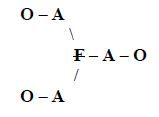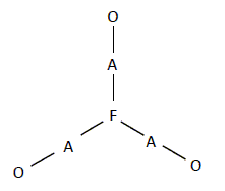Hi Toru, attached is a draft of an OAF introduction. Let me know what you think and what changes you would recommend. Thanks Ed
Unification of USIT to One Graphic Heuristic
Ed Sickafus, Ph. D., Jul. 2, 2015
Introduction
Key ingredients of successful problem solving have always been heuristics – the techniques, tricks, and tools of problem solving. They grew in popularity in the mid 1970s when they began to appear in bundled logically structured packages of verbal and graphic heuristics. Russian technologists immigrating to the USA were teaching a Russian methodology in university engineering departments and some began selling their services in industry. G. S Altshuller invented the Russia methodology TRIZ (Theory of inventive problem solving. Altshuller, G. 1988).
Unified structured inventive thinking (USIT) is a distant cousin of TRIZ.
TRIZ led the way and was followed on this branch of structured problem-solving methodologies by ==>
SIT (Systematic Inventive Thinking, Dr. Horowitz early 1980s) ==>
SIT (Structured Inventive Thinking, Sickafus 1997) adapted Horowitz’s SIT for use in Ford Motor Company and taught it there 1985-2000 retirement) ==>
Heuristic innovation (HI, Sickafus 2006), a thorough analysis and application of the object-attribute-function (OAF) heuristic of USIT ==>
OAF-unification of USIT (Sickafus 2014, ‘Subconscious Problem Solving Using Hazy Heuristics’, presented at IJoSI (The International Journal of Systematic Innovation) also available at www.u-sit.net) ==>
[Sickafus 2015 ‘Introspection—Insight—Inspiration Problem Solving for Innovation’, a totally new problem-solving methodology to be published October 2015 in the proceedings of the ETRIA conference, TFC2015– TRIZ FUTURE 2015, Berlin, Germany (also available in late October 2015, at www.u-sit.net)].
Professor Emeritus Toru Nakagawa has joined USIT and TRIZ in a complimentary combination.
The original work of Dr. Horowitz was devoted to finding simplifications of TRIZ that reduce its steep learning curve. While developing this methodology he taught SIT classes at the Open University in Tel Aviv, Israel, and on-site at local companies.
Following a fundamental interest in theories of problem solving, I continued the emphasis on simplification in adapting SIT to industrial design-type problems with focus on rapid innovation by automotive technologists. After retirement from Ford Motor Company, I developed and published HI in which the object-attribute-function graphic heuristic (OAF) is analyzed thoroughly along with demonstrations of applications in varying complexities. Emphasis was placed on discovering multiple thought paths from a single OAF diagram (Sickafus 2006, HI p.74) – a major reduction of heuristics.
OAF Diagram
In the adaptation of HI to unification of USIT to one graphic heuristic (Sickafus 2014), there has been a slow but steady trend to make it more compact. This trend culminated in recognizing that the OAF diagram contains all of USIT. That recognition is helped by much practice of detailed USIT until its conventional heuristics come to mind automatically without the use of formal analysis. Here’s how it works.
- Collect information for constructing a single-unwanted-effect problem-statement. In the case of multiple unwanted effects, list and prioritize them for addressing individually in later iterations of solution searches. This important step adds knowledge to short-term memory. That, plus extant long-term memory, are all an experienced problem solver needs for generating innovative solution concepts.
- Localize the unwanted effect to a point of contact of two objects. Objects and attributes are metaphors for physical things as well as imagined ones that fit the conditions of an OAF diagram. In most cases surfaces and volumes of homogeneous materials in contact can be reduced mentally to a point of contact. This makes it easier to concentrate on attributes active at a point. An exception can occur when shape of a body is an active attribute.
- Identify all attributes of each object at the point of contact. These are of two types, active attributes and inactive attributes. A word printed in black ink on a sheet of white has attributes at the point of contact: e.g., color, contrast, resolution, readability, absorption, viscosity, bond strength, reflectivity, etc.
- Select pairs of active attributes, one from each of the two contacting objects, that support an unwanted effect (a problem). Each pair can be addressed in iterations of the problem-solving process. In the current example, absorption could interact with viscosity causing an unwanted effect – blurred unreadable symbols. A possible pair of attributes supporting this unwanted effect could be absorption of paper and viscosity of ink. An OAF diagram with these components is shown below. The original design’s desired effect was to be readable.

This example fits the definition of an OAF diagram. The unwanted effect is an unreadable symbol (character, word, script, etc.). The attribute making it unreadable is its definition (notice how the choice of words starts you thinking immediately about possible meanings and perhaps solution concepts). The cause of the problem is at the point of contact of paper and ink, the paper has _____ absorption and/or the ink has _______ viscosity as active attributes. I left the blanks for you to fill in. They play the role of optional modifiers, but not numbers or specifications. Keep them generic for more interpretations, or leave them out. They are not needed explicitly in the OAF diagram. You will think of them as you read the diagram to yourself – over and over as you progress down different solution paths.
You might wonder, in this example, does absorption of paper really interact with viscosity of ink? Does it matter? Think of this way. You are trying to construct seeds for your brain that cause bright ideas to blossom. The specifics of physics and chemistry are useful to your depth of understanding. But you probably can invent new ideas from plausible seeds, which may skirt some technical details. Rather than be too critical of your ideas expand them by testing other wordings as you create new solution paths. The entire exercise is for your mind and no other person’s. You can straighten out details as you are writing your patent application.
If you understand the definition you can build a variety of diagrams for the same problem situation. Each offers more starting paths in solution space.
- Here’s my wording of the OAF diagram. You may prefer another.
‘Two objects in contact at a point have an active attribute which, together, support an unwanted effect that modifies or sustains an attribute of an object.’
When selecting an object, attribute, or unwanted effect to use in the OAF diagram it must fit the details of this wording. In the first OAF diagram, ink and paper interact at a point to sustain the readability of symbol. At least, that was the designer’s intention. Now the design has failed. The first idea to come to my mind is to change the paper material and/or the viscosity of the ink. (Now you try it.)
Bear in mind that more generic your description the more generic solution concepts you may find. Everything is a metaphor. With some thought and practice the three objects can become two or one, depending on the specific conditions of the problem or your choice of words.
OAF solution space
The OAF problem and solution space are generalized in this graphic heuristic, where an effect, F, with a strikeout, F, becomes an unwanted effect. To emphasize logic and clear thinking it can be helpful to practice consistent word types for Os, As, and Fs: use nouns for objects, adjectives for attributes, and infinitives for effects. Adjectives may have modifiers that quantify or restrict – but these are not required.

You can eliminate, activate, exchange, leave as is, or modify any O, A or even F to discover solution concepts. Making F into a solution concept, F, is like selling Post Office misprinted stamps at a high price for their rarity. Unused attributes can be activated for different results. Breaking any of the joining lines destroys F and opens opportunity for new perspective of the problem. Each change made to an OAF diagram becomes the starting point of a search path in solution space.
Update: From USIT to a new methodology, Introspection-Insight-Inspiration
All of USIT, HI, and OAF, plus other heuristics, have referenced the lateralization of the brain model to rationalize separation of the brain hemispheres into different types of functions – a pseudo logical basis. This fall I will be presenting a wholly new problem solving methodology having a basis in the amazing findings in this century from the laboratories of cognitive scientists (Sickafus 2015). The two-hemisphere model has been dropped and the two-thinking-level model of cognitive scientists has been adopted.
References
Altshuller, G. 1988, ‘Creativity as an Exact Science’ Gordon and Breach, by G. Altshuller and translated from the Russian by A.Williams.
Sickafus, E. N.
1997, ‘Unified Structured Inventive Thinking – How to Invent’, ISBN 0-9659535-0-X, (self published, see www.u-sit.net).
2006, ‘Heuristic Innovation’, (self published, see www.u-sit.net).
2014, ‘Subconscious Problem Solving Using Hazy Heuristics’, IJoSI (The International Journal of Systematic Innovation), proceedings of ICSI2014, see also www.u-sit.net.
2015, ‘Introspection—Insight—Inspiration Problem Solving for Innovation’, to be published October 2015 in the proceedings of the ETRIA conference, TFC 2015– TRIZ FUTURE 2015 (also available in October at www.u-sit.net).
Toru, I thought about your comment in the last email,
'...they put burdens on us more than the functional diagrams. ',
and wonder how OAFs should be presented?
You've probably noticed that they were developed after I had used USIT several years and had taught it monthly. So I found myself skipping over a lot of the USIT structure because it came to mind naturally by then.
I have made a habit of talking about the later developments in USIT (and more to come) as appropriate to those who are practiced in structured problem solving. Such practice doesn't have to be USIT. But it needs to be learned well enough that heuristics come to mind when needed.
By the way, OAFs are the only structure I use when doing USIT. An even simpler methodology will be published in October at ETRIA.
It seems to me that the amount of structured problem solving experience needed to move to OAF is a rather personal thing. I have no idea how to judge that for a particular person. To test an answer, I took it to the extreme and wondered if a person could start at OAF without any other SPS training? I concluded it could be done easily, but would require a different approach in teaching, My method would be to teach examples first and then introduce theory.
Any ideas? All the best, Ed





